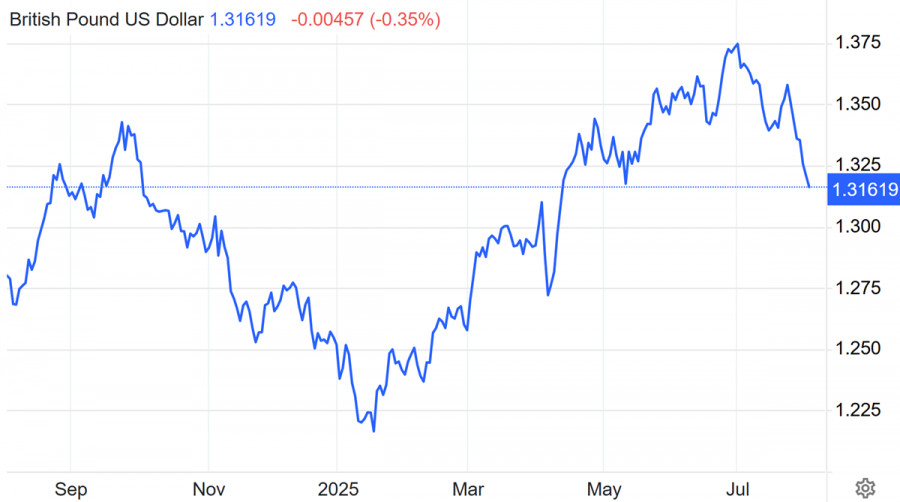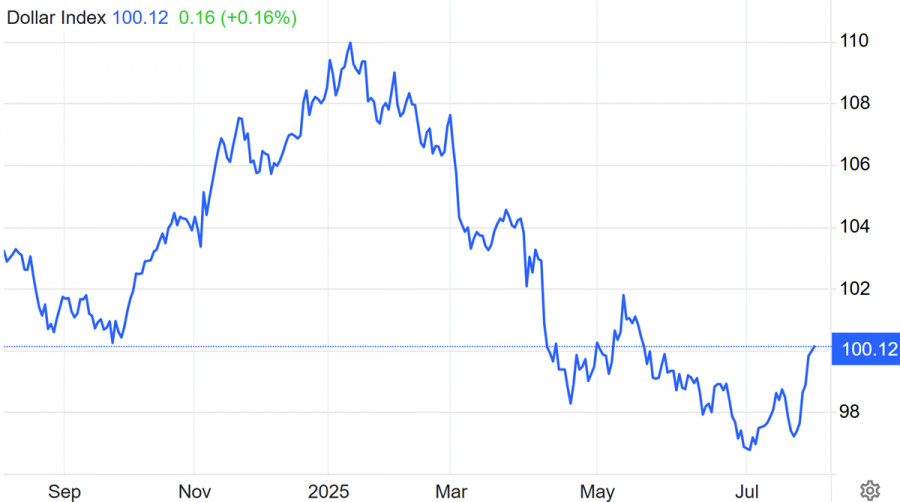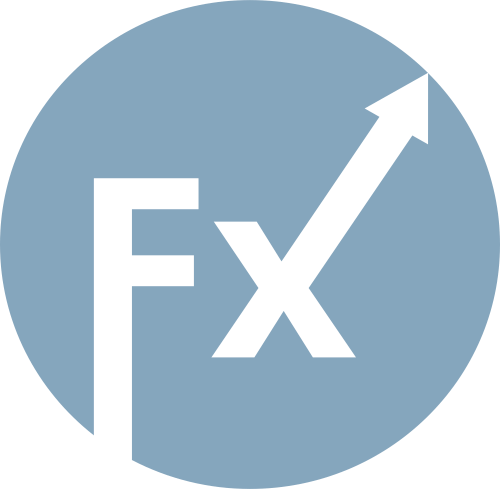July turned out to be the month when the dollar reclaimed its leadership in the currency market, recovering all of June's losses and climbing 3.38% on the index. Fundamental factors played in its favor, and now the US currency is once again at the center of global capital flows.
Firstly, the prolonged political drama surrounding the Federal Reserve has come to an end: Trump eased pressure on the regulator, while the Fed demonstrated maximum independence, reaffirming that interest rates would remain high for as long as necessary to control inflation. The likelihood of a rate cut in September has significantly decreased. Markets interpreted this as a hawkish signal; where previously they had anticipated a near-guaranteed easing in September, many now expect a delay until October or even December, with some believing rates could remain elevated through 2026.
Secondly, the US has stepped up its foreign trade policy, striking several favorable agreements while also imposing new tariffs on imports from dozens of countries. The average tariff rate jumped from 2.3% to 15.2%, a sweeping reconfiguration of global trade aimed at reducing the deficit and supporting domestic production. For the dollar, this means additional demand: every trade win boosts budget revenues, curbs capital outflows, and reinforces confidence in the US economy.
Thirdly, economic data has been unspectacular but steady. The labor market remains the strongest pillar of the economy: jobless claims remain low, and new jobs continue to be created at an accelerating pace.
Incomes and expenditures rose in lockstep in June (both up 0.3%), indicating confidence among American consumers. Even inflation, despite localized spikes, remains under control: core PCE inflation holds at 2.8% year-on-year, and the deflator trend appears broadly balanced.
Notably, despite formal statements from the Fed about slowing growth, Jerome Powell continues to emphasize the strength of the labor market and a moderately restrictive policy stance.
This effectively shuts down talk of a near-term rate cut, at least until the emergence of truly negative economic surprises. Still, two FOMC members voted for a cut, the first time since 1993, signaling internal divisions. Nevertheless, the overall tone remains hawkish, supporting the dollar.
The external backdrop also favors the dollar: US economic growth reached 3% year-over-year in Q2 (following a contraction in Q1), and macro indicators continue to dispel fears of a recession.
There are no signs of significant slowdown or weakening consumer sentiment—America remains an island of stability amid turbulent markets in Europe and Asia.
Technical picture: momentum on USD side
Technically, July was a recovery month for the dollar. The DXY broke through key resistance levels and consolidated near the psychologically important 100.0 mark, a two-month high. Trends in major pairs now clearly favor the greenback:
EUR/USD dropped below 1.1450 and now trades near 1.142, its lowest in 1.5 months. A break below 1.1450 opens the way to 1.136 and 1.13, where key stop orders are likely clustered.
GBP/USD lost nearly 4% in July, hovering around 1.32. Support lies at 1.3160 and 1.3050. Until a reversal trigger appears, the pound remains under pressure.

USD/JPY: The yen is the weakest of the majors. The pair firmly holds above 150, with the next resistance at 152 and a target of 154.
Trading volumes in the dollar are rising, confirming the strength of the trend. While daily indicators show overbought conditions in some pairs, the correction has so far been mild. The dollar lacks a strong external trigger for reversal, and equity and commodity markets remain sluggish in response to macro developments.
The next key target for the DXY is the 100.5–101.1 zone, which hosts significant weekly resistance. A breakout could pave the way toward 102.2–103.

Seasonality also favors the dollar: August historically sees heightened volatility, when many investors lock in profits from risk assets and rotate into safe havens. Markets are beginning to prepare for the fall cycle of Fed and ECB decisions, as well as political events in the U.S. and EU, which further fuels demand for the dollar.
Outlook: USD holds edge, but correction risks rise
August is traditionally volatile for the dollar, but current fundamentals and technicals are clearly in its favor. If no major negative surprises hit the U.S. economy, the DXY could test the 101.5–102.2 range by mid-month. Key drivers include:
Strong US economy: As long as the labor market and consumer activity remain robust, the dollar faces little threat.
Fed policy: Any hints of easing will be countered by hawkish rhetoric. A rate pause already acts as support for the dollar.
Trade wars and tariffs: Every new tariff increases demand for dollars, as companies need more USD liquidity for transactions.
Seasonality: August typically sees increased interest in safe-haven assets amid low liquidity and traditional market shake-ups.
However, as the DXY nears the 101.5–102.2 range, corrections may emerge. Overbought conditions could prompt some speculators to take profits, especially if European and Chinese macro data begin to stabilize or if US labor figures disappoint. Another risk factor lies in US geopolitical tensions and pre-election battles, which could inject volatility.
Trading idea for August:
Buy the dollar on pullbacks against the euro, the pound, and the yen, with tight stops and profit-taking at key resistance levels. Targets: USD/JPY at 152–154, EUR/USD to 1.13, GBP/USD to 1.3050. Corrections are expected to be fast and sharp, so positions should be managed dynamically.
Conclusion:
Summer is a hot season for the dollar. The US economy sets the tempo, while the rest of the world struggles to keep up. Missing out on this trend would be a trader's mistake.

HIZLI BAĞLANTILAR
show error
Unable to load the requested language file: language/turkish/cookies_lang.php
date: 2025-10-04 11:44:01 IP: 216.73.216.129